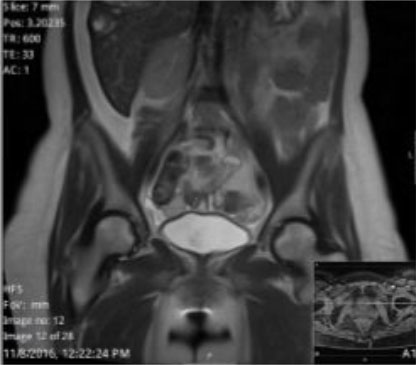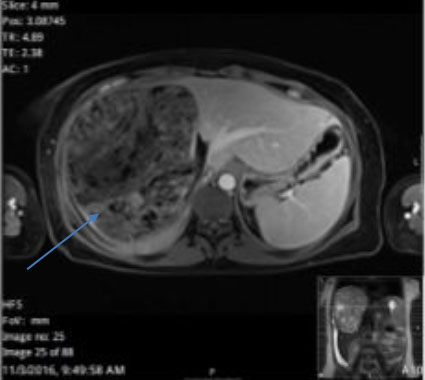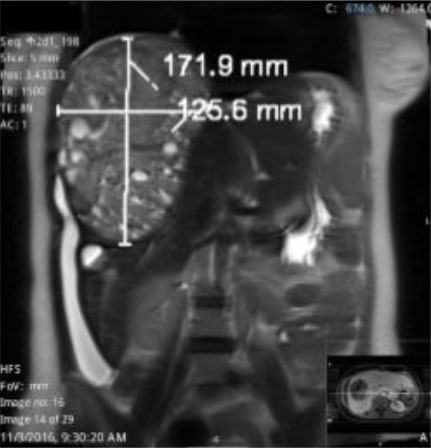 |
Case Report
Grade 4 immature teratoma followed by portal vein embolization and hepatectomy with recurrence: A case report
1 Associate professor, Department of Obstetrics and Gynecology, King Abdulaziz University, Jeddah, Al Edara Street, Po. Box: 802000, Saudi Arabia
2 Teaching assistant, Department of Obstetrics and Gynecology, King Abdulaziz University, Jeddah, Al Edara Street, Po. Box: 802000, Saudi Arabia
3 Resident, Department of General Surgery, King Abdulaziz University, Jeddah, Al Edara Street, Po. Box: 802000, Saudi Arabia
Address correspondence to:
Abdullah Khaled Agabawi
Teaching assistant, Department of Obstetrics and Gynecology, King Abdulaziz University, Jeddah, Al Edara Street, Po. Box: 802000,
Saudi Arabia
Message to Corresponding Author
Article ID: 100026G06AM2022
Access full text article on other devices

Access PDF of article on other devices

How to cite this article
Mousa AA, Agabawi AK, Rozzah RS, Abdulwasie HK. Grade 4 immature teratoma followed by portal vein embolization and hepatectomy with recurrence: A case report. Edorium J Gynecol Obstet 2022;7(1):6–10.ABSTRACT
Introduction: Immature teratomas or in another way malignant germ cell tumors are considered a very rare type of aggressive ovarian cancers. Of teratomas it represents 1%. In ovarian cancers it still presents 1% and as an overall it presents 35.6% of all malignant ovarian germ cell tumors. In most cases it has been found during the first two decades of life.
Case Report: The present case describes a case of a patient who was diagnosed with immature teratoma that was treated surgically and discovered sooner to have a liver metastasis that was treated with hepatic embolization and hepatectomy. Furthermore, she developed recurrence with lung metastasis that was intended to be treated with chemotherapy.
Conclusion: Prognosis of this type of cancer is reported to be good as long as it is discovered and treated early in the course. Patients usually present before metastasis. In terms of liver metastasis our patient had a hepatic embolization followed by a right hepatectomy which when compared to other reported cases almost all had a hepatectomy without embolization. Five months later our patient presented with lung metastasis which is uncommon specially after the patient had a right hepatectomy. Based on these findings our patient had a very short disease-free period which is not typical for this kind of disease. Platinum-based chemotherapy is considered the standard of care as an adjuvant therapy. This patient showed resistance to cisplatin where up to our knowledge there were no reported cases that had resistance to this regimen.
Keywords: Grade 4 immature teratoma, Embolization, Hepatectomy, Liver metastasis, Teratoma recurrence
INTRODUCTION
Immature teratomas or in another way malignant germ cell tumors are considered a very rare type of aggressive ovarian cancers. Of teratomas it represents 1%. In ovarian cancers it still presents 1% and as an overall it presents 35.6% of all malignant ovarian germ cell tumors. In most cases it has been found during the first two decades of life [1]. Initially, germ cell tumors are further divided into immature and mature teratomas [2]. In comparison, Immature teratomas appear most commonly during the first two decades of life in contrast to the mature ones which develop between the 20s to 40s. Both types have very high rates of recurrence and metastasis [3].
The present case describes a case of a patient who was diagnosed with immature teratoma that was treated surgically and discovered sooner to have a liver metastasis that was treated with hepatic embolization and hepatectomy. Furthermore, she developed recurrence with lung metastasis that was intended to be treated with chemotherapy.
CASE REPORT
This is 25-year-old woman who had a previous uncomplicated vaginal delivery and is pleasantly married for 10 years. She is of a known Yemeni descent. Originally, she was medically and surgically free with good general health. This patient was in her usual state of health until two years ago after delivering her 2-year-old baby. On that occasion, she had a sudden onset of a rapidly progressive ascites that was noted at a private hospital. This unusual presentation in her status wasn’t associated with any abdominal pain, vomiting, changes in bowel habit, urinary symptoms, or any other signs of liver involvement. This ascites developed very fast to the level where the patient started complaining of shortness of breath. This was not associated with weight loss, loss of appetite, or even fever. Extensive work-up was done to her including a magnetic resonance imaging (MRI) of her pelvis (Figure 1). On the pelvis ultrasound, she was found to have a large left ovarian mass. Accordingly, she had a left salpingo-oophorectomy with an omentectomy. Histopathology defined the mass to be an immature teratoma. On the other hand, she was also found to have an evidence of hepatic metastasis putting her in a stage 4 immature teratoma. As a result, she was started on chemotherapy in which she had 5 cycles. Eight months later she was admitted under our care at King Abdulaziz University Hospital (KAUH) for a right hepatic embolization which was followed with a right hepatectomy (Figure 2 and Figure 3). On 1/1/2017 the patient was admitted to the operation room for right hepatectomy and a right ovarian cystectomy for a dermoid cyst. Intraoperatively, she received eight units of packed red blood cells (PRBC), six units of fresh frozen plasma (FFP), and six units of platelets. Estimated blood loss was 5 Liters and immediately she was transferred post-operatively to the intensive care unit (ICU). Three days later she was transferred in a satisfactory condition to the surgical unit. Unfortunately, a day later some bile collections were noted and discovered to be extended-spectrum β-lactamases (ESBL) positive. Pleural effusion was also discovered which was drained by pleural taping. The infection was treated thereafter, and the patient was discharged later on in good condition. On 2/3/2017 she was admitted again for the sixth cycle of chemotherapy which she didn’t complete because she had a lung infection. Two months later and on 10/5/2017 she came again to our emergency room complaining of productive cough that is bloody tinged associated with shortness of breath without activity and subjective fever for three days. Chest X-ray was done immediately which showed a large pleural effusion which was tapped and sent for testing. Moreover, computed tomography (CT) chest was also done which showed a large solid mass occupying the right hemithorax and obstructing the right middle and lower lobar bronchi in association with right upper and middle lobe pulmonary arteries and veins narrowing (Figure 4). Phrenic and lateral mammary lymph nodes were noted to be enlarged. These finding were accompanied by a right middle and lower lobe pneumonia with right pleural effusion. Immediately, ceftriaxone was started for ten days. Results came back with an evidence of recurrence and extensive lung metastasis. Plan was taken to resume with a sixth cycle of chemotherapy as no further surgical intervention is to be done. The patient died at the 31st of July 2017.
DISCUSSION
Reported stage IV immature ovarian teratomas compromised 4% or less of all immature ovarian teratoma cases reported in the Surveillance, Epidemiology, and End Results (SEER) database from years 1973–2012 and in the National Cancer Data Base (NCDB) [4],[5]. Prognosis of this type of cancer is reported to be good as long as it is discovered early and treated, and worse prognosis is reported if the cancer is of a higher grade and higher stage patients with a reported 5-year survival of 72% for stage IV cases [5].
Our case presented at an age of 25 years old, Alwazzan et al. reported that the median age for presentation in their study which included 1332 patients was 27 years old, but it’s worth noting that the highest stage they reported was stage III cancer [6]. Immature teratoma cases usually present before metastasis, and they usually present complaining of abdominal pain followed by noticing an abdominal mass, although some cases present complaining of abdominal mass [7].
When treating the liver metastasis our case underwent a hepatic embolization which was followed with a right hepatectomy, while in reported cases of liver metastasis the treatment is always surgical resection, without the hepatic embolization [8],[9]. In a Chinese study the 3-year-survival rate for liver metastasis was reported to be 77.8%, while the mortality rate was 22.2%. Furthermore, the reported 5- and 10-year-survival rate was 55.6% and 38.9%, respectively [8].
While it is not much reported in the literature, our case had a lung recurrence five months after the right hepatectomy was done, while Matsumoto et al. reported a lung and hepatic recurrence 16 years after the last treatment which is the longest reported disease-free period [10], recurrence in general is reported years after treatment of the primary tumor, as for a reported case with a recurrence in the aortic bifurcation six years after treatment [11]. Compared to reported cases our patient is considered to have a short disease-free period.
We screened our patient with the alpha-fetoprotein (AFP), carcinoembryonic antigen (CEA), lactate dehydrogenase (LDH), human chorionic gonadotropin (HCG), and the CA-125. In our patient only the CA-125 was high before the first surgery and it was raised again when the recurrence happened, while other studies reported a rise in AFP levels along with the CA-125, LDH, and HCG [12]. Alpha-fetoprotein is reported to be elevated in 50% of cases of immature teratomas [2].
The literature on immature teratoma, particularly stage IV, is limited. And although platinum-based chemotherapy regimens are considered standard of care for patients in whom adjuvant treatment is indicated [6], our patient showed resistance to cisplatin and up to our knowledge no reported cases had resistance to the regimen. Finally, lung metastasis is only reported in few cases to compare with.
CONCLUSION
Patients usually present before metastasis. In terms of liver metastasis our patient had a hepatic embolization followed by a right hepatectomy which when compared to other reported cases almost all had a hepatectomy without embolization. Five months later our patient presented with lung metastasis which is uncommon specially after the patient had a right hepatectomy. Based on these findings our patient had a very short disease-free period which is not typical for this kind of disease. Platinum-based chemotherapy is considered the standard of care as an adjuvant therapy. This patient showed resistance to cisplatin where up to our knowledge there were no reported cases that had resistance to this regimen.
REFERENCES
1.
Smith HO, Berwick M, Verschraegen CF, et al. Incidence and survival rates for female malignant germ cell tumors. Obstet Gynecol 2006;107(5):1075–85. [CrossRef]
[Pubmed]

2.
Saba L, Guerriero S, Sulcis R, Virgilio B, Melis G, Mallarini G. Mature and immature ovarian teratomas: CT, US and MR imaging characteristics. Eur J Radiol 2009;72(3):454–63. [CrossRef]
[Pubmed]

3.
Chang CF, Lin CK. A case of recurrent, bilateral ovarian mature teratoma in a young woman. BMC Womens Health 2014;14:57. [CrossRef]
[Pubmed]

4.
Chan JK, Gardner AB, Chan JE, Guan A, Alshak M, Kapp DS. The influence of age and other prognostic factors associated with survival of ovarian immature teratoma—A study of 1307 patients. Gynecol Oncol 2016;142(3):446–51. [CrossRef]
[Pubmed]

5.
Jorge S, Jones NL, Chen L, et al. Characteristics, treatment and outcomes of women with immature ovarian teratoma, 1998–2012. Gynecol Oncol 2016;142(2):261–6. [CrossRef]
[Pubmed]

6.
Alwazzan AB, Popowich S, Dean E, Robinson C, Lotocki R, Altman AD. Pure immature teratoma of the ovary in adults: Thirty-year experience of a single tertiary care center. Int J Gynecol Cancer 2015;25(9):1616–22. [CrossRef]
[Pubmed]

7.
Deodhar KK, Suryawanshi P, Shah M, Rekhi B, Chinoy RF. Immature teratoma of the ovary: A clinicopathological study of 28 cases. Indian J Pathol Microbiol 2011;54(4):730–5. [CrossRef]
[Pubmed]

8.
Fan Q, Huang H, Lian L, Lang J. Characteristics, diagnosis and treatment of hepatic metastasis of pure immature ovarian teratoma. Chin Med J (Engl) 2001;114(5):506–9.
[Pubmed]

9.
Kurata A, Hirano K, Nagane M, Fujioka Y. Immature teratoma of the ovary with distant metastases: Favorable prognosis and insights into chemotherapeutic retroconversion. Int J Gynecol Pathol 2010;29(5):438–44. [CrossRef]
[Pubmed]

10.
Matsumoto H, Mizoguchi C, Nishida M, Sato S, Nasu K, Narahara H. Recurrent immature teratoma of the ovary with long-term disease-free interval. J Obstet Gynaecol Res 2014;40(5):1455–8. [CrossRef]
[Pubmed]

11.
Wu X, Han LY, Xu X, Li Z. Recurrent immature teratoma of the ovary: A case report of radical secondary cytoreduction with replacement of the aortic bifurcation. Gynecol Oncol 2004;95(3):746–9. [CrossRef]
[Pubmed]

12.
Reddihalli PV, Subbian A, Umadevi K, et al. Immature teratoma of ovary – outcome following primary and secondary surgery: Study of a single institution cohort. Eur J Obstet Gynecol Reprod Biol 2015;192:17–21. [CrossRef]
[Pubmed]

SUPPORTING INFORMATION
Author Contributions
Ahmed A Mousa - Conception of the work, Design of the work, Acquisition of data, Analysis of data, Drafting the work, Revising the work critically for important intellectual content, Final approval of the version to be published, Agree to be accountable for all aspects of the work in ensuring that questions related to the accuracy or integrity of any part of the work are appropriately investigated and resolved.
Abdullah Khaled Agabawi - Conception of the work, Design of the work, Acquisition of data, Analysis of data, Drafting the work, Revising the work critically for important intellectual content, Final approval of the version to be published, Agree to be accountable for all aspects of the work in ensuring that questions related to the accuracy or integrity of any part of the work are appropriately investigated and resolved.
Rayan S Rozzah - Conception of the work, Design of the work, Acquisition of data, Analysis of data, Drafting the work, Revising the work critically for important intellectual content, Final approval of the version to be published, Agree to be accountable for all aspects of the work in ensuring that questions related to the accuracy or integrity of any part of the work are appropriately investigated and resolved.
Hassan K Abdulwasie - Conception of the work, Design of the work, Acquisition of data, Analysis of data, Drafting the work, Revising the work critically for important intellectual content, Final approval of the version to be published, Agree to be accountable for all aspects of the work in ensuring that questions related to the accuracy or integrity of any part of the work are appropriately investigated and resolved.
Guaranter of SubmissionThe corresponding author is the guarantor of submission.
Source of SupportNone
Consent StatementWritten informed consent was obtained from the patient for publication of this article.
Data AvailabilityAll relevant data are within the paper and its Supporting Information files.
Conflict of InterestAuthors declare no conflict of interest.
Copyright© 2022 Ahmed A Mousa et al. This article is distributed under the terms of Creative Commons Attribution License which permits unrestricted use, distribution and reproduction in any medium provided the original author(s) and original publisher are properly credited. Please see the copyright policy on the journal website for more information.









